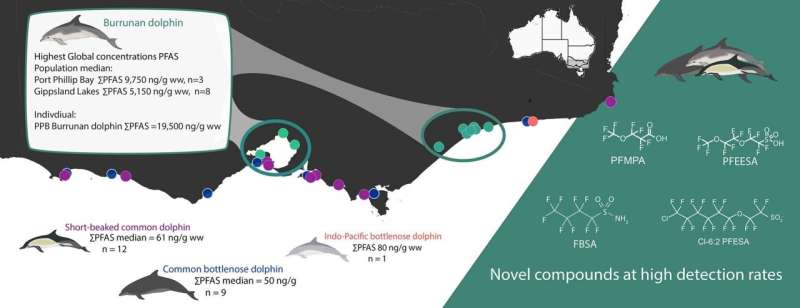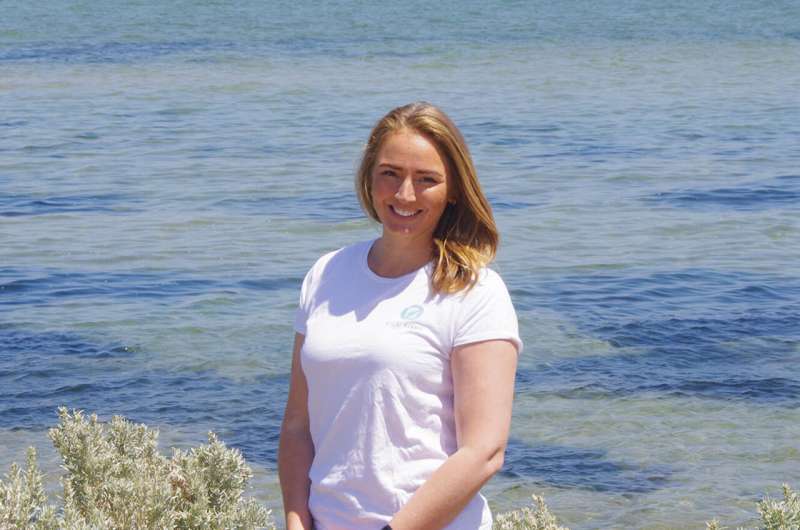This article has been reviewed according to Science X's editorial process and policies. Editors have highlighted the following attributes while ensuring the content's credibility:
fact-checked
peer-reviewed publication
trusted source
proofread
Critically endangered Victorian dolphins suffering highest known levels of PFAS pollutants, study finds

Dolphins in the waters off Melbourne and Gippsland have been found with the highest concentrations of PFAS chemicals in dolphins reported anywhere in the world, according to new research.
The joint study by scientists from the Marine Mammal Foundation, RMIT and Melbourne University found alarming concentrations of the chemicals—widely used in food packaging, firefighting foam and non-stick cookware and notoriously known as "forever chemicals" for not breaking down—in Victoria's critically endangered Burrunan dolphins.
Samples were taken from 38 dolphins of various species found stranded along Victoria's coastline, but especially high PFAS liver concentrations were found among the Burrunan dolphin populations of Port Phillip Bay and Gippsland Lakes.
Average concentrations of some chemicals in these populations were more than 10 times higher than what scientists believe causes liver toxicity and a range of health issues.
One juvenile Burrunan dolphin from Port Phillip Bay had a PFAS liver concentration of 19,500 nanograms per gram—the highest level recorded in an individual dolphin globally.
Study lead author Chantel Foord said these results are both highly concerning and globally significant.

"Not only did we find the highest levels of these man-made toxicants in a species that's already critically endangered—including in newborn and juveniles—we also found one dolphin from Port Phillip Bay with PFAS concentrations almost 30% higher than any other individual dolphin reported globally," said Foord, who is a joint Ph.D. researcher with both RMIT's Ecotoxicology Research Group and the Marine Mammal Foundation.
Foord said these results did not necessarily mean risk to humans in Victorian waters: dolphins ingest whole fish including the liver, which accumulates these pollutants, whereas we only eat fish muscle tissue.
Major sources of PFAS in the aquatic environment have been attributed to manufacturing effluent, wastewater treatment plant discharge, urban and landfill run-off and firefighting foams used on land near waterways.
While there is international regulation for some of these chemicals, Australia has yet to ratify the Stockholm Convention on Persistent Organic Pollutants in full, enabling their import for use in a range of products over decades.
The ground-breaking research, published as "Hepatic concentrations of per- and polyfluoroalkyl substances (PFAS) in dolphins from south-east Australia: Highest reported globally" in Science of the Total Environment, highlights the mystery behind this pollution of marine mammals, as no PFAS manufacturing occurs in Australia.
Foord emphasized the need to identify the sources and understand how these chemicals behave in the environment.
"While we would expect higher concentrations in locations where these chemicals are made, that is not what this study found," she said. "So, without manufacturing occurring in Australia, why are we recording these alarming PFAS levels?
"Most importantly, how are they going to impact the viability of these dolphin populations?"
The study also revealed emerging contaminants in the environment, indicating that newer replacement chemicals are already bioaccumulating through the food web to the dolphins.
A critically endangered dolphin
The Burrunan dolphin was first described as a separate species in 2011 by Marine Mammal Foundation Director, Dr. Kate Robb, also a co-author of this study.
Sadly, it's already critically endangered.
Robb said the only two known populations—in Port Phillip Bay and the Gippsland Lakes—are both small and already at high risk of localized extinction.
"With only 250 individuals across these populations, increasing our understanding of threatening processes is absolutely crucial for the conservation and protection of the Burrunan dolphin, and in the management and mitigation of those threats," she said.
"Given the current immune compromising risks and health impacts associated with PFAS exposure, it is incredibly concerning that these Burrunan dolphins studied have the highest level of documented PFAS worldwide, especially due to their high vulnerability and risk of extinction."
"This study highlights how crucial it is that we continue our vital research to ensure the future of the species."
More information: Chantel S. Foord et al, Hepatic concentrations of per- and polyfluoroalkyl substances (PFAS) in dolphins from south-east Australia: Highest reported globally, Science of The Total Environment (2023). DOI: 10.1016/j.scitotenv.2023.168438
Journal information: Science of the Total Environment
Provided by RMIT University




















